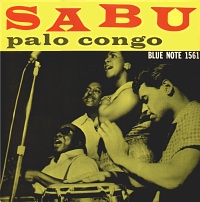|
The emotional kinship between the world of this recording and the world of jazz seems so strong at times that the distance between the worlds seems no wider than the pavement of West Fifty-Fourth Street which separates the Museum of Primitive Art from the Museum of Modern Art. Yet the step from Afro-Cuban music to jazz is a long step, for the European elements of jazz are always in the foreground, while here the latin elements of "latin" music are often imperceptible. It is mostly Africa that we hear in this recording: some rituals dedicated to African Gods, a good deal of singing and chanting in African antiphonal style, and all the instruments, whether obviously African like the quinto, a Cuban version of the slit signal drum, or as apparently European as guitar and bass, played like their African proto-types in African musical tradition. Still, the kinship is there to hear, for Afro-Cuban music shares with jazz the intense motor excitement, the rhythmic fluidity that Andre Hodeir calls vital drive, and the striving for ecstatic communion which supplies much of the motive force. Sabu, the leader of this date, is one of the many musicians of both traditions who have tried to find common ground. He has played with such jazz musicians os Dizzy Gillespie, Charlie Parker, Thelonious Monk, J.J. Johnson, Gigi Gryce, and Art Blakey. For this purely Afro-Cuban record Sabu has drawn more on the other half of his experience, the many latin groups he has worked with since he mode his professional debut at the age of 11 in 1941. Before he formed his own quintet this year Sabu worked with the bands of Marcelina Guerro, Esy Morales, Nora Morales, and Miguelito Valdez. He was a member of the original Joe Loco Trio, accompanist to dancer Josephine Premice and singer Harry Belafonte, and played in the Broadway show, "House of Flowers." Arsenio Rodriquez is featured as guitarist, drummer, and chanteur. Arsenio and his two brothers, Raul "Caesar" Travieso and Israel Moises "Quique" Travieso, grew up in Cuba with Miguelito Valdez and Chano Pozo, often worked together, and composed many Cuban pop songs together. Before coming to New York nine years ago, Arsenio led one of the finest bands in Cuba. He now leads his own band in New York, in which Caesar and Quique both play, as does bassist Evaristo Baro. Ray "Mosquito" Romero has played with Miguelito Valdez and accompanied Eartha Kitt. The singers are Sarah Baro, Mrs. Evaristo Baro, and Willie Capo, both of Arsenio Rodriguez' group. | El Cumbanchero begins with a vocal introduction by Sabu, asking everyone to listen to the drum which expresses his soul, followed by two Sabu solos on the woody-sounding quinto, sandwiching a rhythmic guitar solo by Arsenio. Billumba - Palo Congo is a fragment of religious ritual, with Arsenio preaching in an Afro-Cuban cult dialect to antiphonal responses by the group. The rhythmic pattern which accompanies the chanting is a multi-voiced 8/8 with a series of accents on conga by Mosquito varying from single quarter notes on the downbeat, to off-beat triplets, to the syncopated 1/8 -- 1/16 -- 1/8 -- 1/16 -- 1/8 pattern of the cinquillo. Choferito - Plena is in a lighter groove, with Willie Capo singing lead in a little Puerto Rican plaint:
Asabache is a four-drum seminar with Quique on golpe, Arsenio on tumbadore, Caesar on quinto, and Sabu on llamador. The two middle voices combine to play a pattern of two 8/8 bars, against higher-pitched free accents and a bottom of a 3/4 pattern, often played with only the first quarter sounded. Simba is a fantasy describing a lion hunt with Sabu chanting out the story against a shifting rhythmic background, beginning in 8/8 moving to 2/2, and then alternating while Sabu plays cowbell with off-phase shifts between 2/2 and 6/8. Rhapsodia del Maravilloso is a guitar solo by Arsenio Rodriguez, whose lines ore far from the world of modern jazz, but who shows an emotional authority and rhythmic sureness comparable to such a traditional jazz artist as Pete Johnson. Aggo Elegua is another fragment of ritual, a choral salutation of the Yoruba (Nigerian) deity, called Saint Elegua in the Cuban cult, who guards the crossroads and human fertility, sung in an Afro-Cuban cult dialect led by Caesar while Sabu plays a 2/8 pattern on quinto against the 6/8 of the voices. Tribilin Cantore is the most latin of the pieces here, a gentle pastoral tribute to the scenery, climate, and products of beautiful Cuba, with more guitar by Arsenio and an extremely manic bass solo by Evaristo Baro. Altogether a happy trip to a musical world with rather different rules, but neither artless nor lacking its own brand of musical sophistication. -- Hsio Wen Shih |
 |
 |
© 1997 Hip Wax
